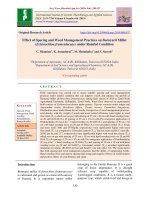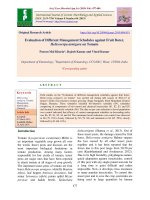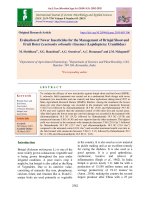Varietal preference of okra shoot and fruit borer, Earias vittella (Fab.) in summer season under field condition in Konkan region of Maharashtra
Bạn đang xem bản rút gọn của tài liệu. Xem và tải ngay bản đầy đủ của tài liệu tại đây (139.42 KB, 6 trang )
Int.J.Curr.Microbiol.App.Sci (2018) 7(11): 2397-2402
International Journal of Current Microbiology and Applied Sciences
ISSN: 2319-7706 Volume 7 Number 11 (2018)
Journal homepage:
Original Research Article
/>
Varietal Preference of Okra Shoot and Fruit Borer, Earias vittella (Fab.) in
Summer Season under Field Condition in Konkan Region of Maharashtra
Vinayak N. Jalgaonkar1*, Manoj Mahla2, Kumud Naik3,
Anil Vyas2 and Gopal Golvankar3
1
Entomologist Regional Agricultural Research Station, Karjat, Dist. Raigad – 410201
(M.S.), India
2
Department of Entomology, Rajasthan College of Agriculture, Maharana Pratap University
of Agriculture and Technology, Udaipur-313001 (Rajasthan), India
3
Department of Entomology, College of Agriculture, Dr. BSKKV, Dapoli, Dist.
Ratnagiri, 415712 (M.S.), India
*Corresponding author
ABSTRACT
Keywords
Okra, okra shoot and fruit
borer, Eariasvittella,
Variety preference
Article Info
Accepted:
18 October 2018
Available Online:
10 November 2018
The field experiment was conducted to study the varietal preference of okra shoot and fruit
borer, Earias vittella (Fab.) under field condition in Konkan region during summer 2016
and 2017 at RARS, Karjat. There were eight varieties viz., ArkaAnamika, Akola 10, Akola
Bahar, PhuleUtakarsh, GOA-5, ParbhaniKranti, Panjab, Padmini, and VarshaUpahar (as a
check) were screened for their relative susceptibility to okra shoot and fruit borer under
field conditions. Among the eight genotypes/varieties of okra, none of the cultivars was
found to be free from pest infestation in the year 2016 and 2017. The minimum shoot
damage was recorded on variety Akola bahar (12.98%), whereas the maximum damage
was recorded on Punjab Padmini (26.81%). The per cent fruit damage revealed that the
infestation fruit damage ranged from 21.29 to 36.38 per cent on different
genotypes/varieties. The variety Akola 107 recorded less damage (21.29%) to fruits as
compared to rest of the other varieties.
Introduction
Several insect pests have so far been recorded
to attack okra like okra shoot and fruit borer
(OSFB), jassid, aphid, whitefly, and cotton
leaf roller. Among these pests OSFB
(Eariassp.) is considered as the most
important one (Aziz et al., 2011) which causes
both quantitative and qualitative losses of the
okra crop (Butani and Jotwani, 1984). Earias
sp. alone causes damage up to71% (Pareek
and Bhargava, 2003) whereas in general the
overall pod damage is about 49% and 42%
according to Kanwar and Ameta (2007) and
Fletcher and Mishra (1990) respectively.
Moreover, Radake and Undirwade (1981)
reported that 88-100% fruits can be damaged
by the okra shoot and fruit borer. The adult
female okra shoot and fruit borer lays eggs
individually on leaves, floral buds and on
tender fruits. After hatching, small brown
caterpillars bore into the top shoot and feed
2397
Int.J.Curr.Microbiol.App.Sci (2018) 7(11): 2397-2402
inside the shoot before fruit formation. The
shoots wilt and dry results the development of
side branches. When fruits become available,
caterpillars bore into the fruits and feed inside
as a result the infested plant bears smaller and
deformed pods (Mohan et al., 1983).
Knowledge on varietal preference of okra
shoot and fruit borer can play a significant role
in the successful okra production and its
management. Unfortunately, very limited
efforts were given in this regards. Considering
the above situation, the present research was
conducted to screen out the resistant okra
variety which might be an important tool for
the management of this pest.
Materials and Methods
A statistically designed field experiment was
laid out in uniform sized plots in Randomized
Block Design at Regional Agriculture
Research Station, Karjat (M.S). The row to
row and plant to plant spacing for okra was
maintained at 45 cm and 30 cm respectively.
Sowing of okra was done in the 1st week of
February in the year 2016 and 2017. The
details of the experiment are given below.
spacing at Regional Agriculture Research
Station, Karjat (M.S). All the recommended
agronomical practices were adopted for
raising the crop. The plot of these varieties
was kept unsprayed with any insecticide
throughout the crop season.
Method of recording observations
Shoot and
(Fabricius)
fruit
borer,
Eariasvittella
The observations on shoot infestation and
flower bud infestation were recorded from five
randomly selected plants from each plot.
There was no shoot infestation and flower bud
infestation was minor. The observations on
fruit infestation were recorded from five
randomly selected plants from each plot. Total
number of fruits, healthy fruits and infested
fruits were recorded from five randomly
selected plants from each treatment. The per
cent infestation was worked out on the basis of
healthy and infested fruits on number basis.
The data was converted into per cent infested
fruit and analysed statistically.
Results and Discussion
Experimental details
Screening of different okra germplasm
against okra shoot and fruit borer
Crop: Okra
Variety: Eight (8)
Design: RBD
Season: Summer season crop
Spacing: 45 cm X 30 cm
Plot size: 2.5 m X 3.00 m
Eight varieties viz., ArkaAnamika, Akola 10,
Akola Bahar, PhuleUtakarsh, GOA-5,
ParbhaniKranti, Panjab, Padmini, and
VarshaUpahar (as a check) were screened for
their relative susceptibility to okra shoot and
fruit borer under field conditions during
summer season of year 2016 & 2017. Each
variety was grown in a gross plot of 2.5 X
3.00 m with three replications and 45 X 30 cm
Results of the field experiment conducted
during summer season of 2016 and 2017 at
Regional Agricultural Research Station, Karjat
(Maharashtra) to screen different okra
germplasm reaction against major arthropod
pests are mentioned below:
Summer season 2016
Shoot damage
The result was pertaining in Table 1. The data
on mean shoot damage recorded from
different genotypes/varieties of okra revealed
2398
Int.J.Curr.Microbiol.App.Sci (2018) 7(11): 2397-2402
that, among nine genotypes/varieties of okra,
none of the cultivars was found to be free
from the infestation of shoot damage. The
percent shoot damage by this pest varied from
12.98 to 26.81 percent. It indicates the varying
response of all the varieties/genotypes to shoot
damage.
The minimum shoot damage was recorded on
variety Akola Bahar (12.98%), whereas the
maximum damage was recorded on Punjab
Padmini (26.81%). The Cultivars viz.,
PhuleUtkarsha, VarshaUpahar, GOA -5,
ArkaAnamika,
Akola
107,
and
ParbhaniKranti, recorded 15.89, 19.85, 22.00,
22.51, 22.95 and 24.37 percent damage
respectively.
Fruit damage
A close perusal of the data on percent fruit
damagewas pertaining in Table 1 and revealed
that the infestation of fruit damage ranged
from 24.42 to 36.38 percent on different
genotypes/varieties. The variety Akola Bahar
recorded less damage (24.42%) to fruits as
compared to rest of the other varieties. The
maximum fruit damage was recorded in the
variety ParbhaniKranti (36.38%). The
Cultivars viz., PhuleUtkarsha, VarshaUpahar,
Akola 107, Punjab Padmini, GOA -5 and
ArkaAnamika recorded 27.64, 28.59, 31.86,
32.82 and 34.57 percent damage respectively.
Among eight genotypes/varieties of okra none
of the cultivars was found to be free from the
infestation of fruit damage.
from the infestation of shoot damage. The
percent shoot damage varied from 16.75 to
24.54 percent. It indicates the varying
response of all the varieties/genotypes to shoot
damage.
The minimum shoot damage was recorded on
variety Akola Bahar (16.75%), whereas the
maximum damage was recorded on Punjab
Padmini (26.81%). The Cultivars viz.,
PhuleUtkarsha, VarshaUpahar, GOA -5,
ArkaAnamika,
Akola
107,
and
ParbhaniKranti, recorded 17.31, 18.14, 19.96,
20.26, 20.90 and 21.05 percent damage
respectively.
Fruit damage
A close perusal of the data on percent fruit
damage was pertaining in Table 2 and
revealed that the infestation of fruit damage
ranged from 21.29 to 31.59 percent on
different genotypes/varieties. The variety
Akola 107 recorded less damage (21.29%) to
fruits as compared to rest of the other
varieties.
The maximum fruit damage was recorded in
the variety GOA- 5 (31.59%). The Cultivars
viz.,
ArkaAnamika,
PhuleUtkarsha,
ParabhaniKranti, Punjab Padmini, Akola
bahar and VarshaUpahar recorded 31.01,
29.76, 29.43, 29.32, 27.81 and 26.20 percent
damage
respectively.
Among
eight
genotypes/varieties of okra none of the
cultivars was found to be free from the
infestation of fruit damage.
Summer season 2017
Shoot damage
The result was pertaining in Table 2. The data
on mean shoot damage recorded from
different genotypes/varieties of okra revealed
that, among nine genotypes/varieties of okra,
none of the cultivars was found to be free
These findings are in close conformity with
the findings of Banger et al., (2012), reported
that, out of 10 varieties screened, the variety
AOL 05-1, Gujarat Okra-2 AOL 08-2 were
least susceptible for fruit borer. Gonde et al.,
(2012) reported that the lowest infestation on
number basis was recorded in EMS 8-1
followed by Punjab Padmini and VRO 3.
2399
Int.J.Curr.Microbiol.App.Sci (2018) 7(11): 2397-2402
Table.1 Screening of different okra germplasm against Shoot and fruit borer,
Earias vittella (Fab) during 2016
Sr. No.
Genotypes/varieties
1
T1 = VarshaUpahar
2
T2 = Akola Bahar
3
T3 = PhuleUtakarsh
4
T4 = GOA-5
5
T5 = ArkaAnamika
6
T6 = Punjab Padmini
7
T7 = ParbhaniKarnti
8
T8 = Akola 107
Mean
SE
CD
Mean damage percentage
Shoot damage (%)
Fruit damage (%)
19.85
28.59
(26.42)
(32.27)
12.98
24.42
(21.05)
(29.60)
15.89
27.64
(23.42)
(31.69)
22.00
34.57
(27.97)
(35.97)
22.51
33.02
(28.32)
(35.06)
26.81
32.82
(31.18)
(34.94)
24.37
36.38
(29.53)
(37.05)
22.95
31.86
(28.59)
(34.33)
20.92
31.16
(27.06)
(33.86)
0.08
0.23
0.24
0.70
Table.2 Screening of different okra germplasm against Shoot and fruit borer,
Eariasvittella (Fab) during 2017
Sr. No.
Genotypes/varieties
1
T1 = VarshaUpahar
2
T2 = Akola Bahar
3
T3 = PhuleUtakarsh
4
T4 = GOA-5
5
T5 = ArkaAnamika
6
T6 = Punjab Padmini
7
T7 = ParbhaniKarnti
8
T8 = Akola 107
Mean
SE
CD
Mean damage percentage
Shoot damage (%)
Fruit damage (%)
18.14
26.20
(25.18)
(30.79)
16.75
27.81
(24.12)
(31.82)
17.31
29.76
(24.58)
(33.02)
21.05
31.59
(27.28)
(34.14)
20.26
31.01
(26.71)
(33.83)
24.54
29.32
(29.67)
(32.77)
20.90
29.43
(27.20)
(32.83)
19.96
21.29
(26.78)
(27.48)
19.86
28.30
(26.44)
(32.09)
0.36
0.11
1.12
0.33
2400
Int.J.Curr.Microbiol.App.Sci (2018) 7(11): 2397-2402
Varietal details
T1 = VarshaUpahar
T3 = PhuleUtakarsh
T5 = ArkaAnamika
T7 = ParbhaniKarnti
T2 = Akola Bahar
T4 = GOA-5
T6 = Panjab Padmini
T8 = Akola 107
Similar results found by Kaur et al., (2013)
recorded low mean fruit infestation (18.0918.68% and 18.10-19.68 %, fruit in number
and weight basis, respectively) was observed
in Punjab- Padmini and Punjab-8 as against
Punjab-7 (22.27 -23.29% fruit in number and
weight basis). Rehman et al., (2015)
evaluated seven okra varieties viz., Taj
Vendhi, BARI Dharos- 1, ArkaAnamika,
Green Finger, Green Soft, OK-285 and Nabik
against okra shoot and fruit borer. Among the
seven varieties, Taj Vendhi was the most
preferable variety as the highest average shoot
(26%) and fruit (24%) infestation were
recorded. On the contrary, ArkaAnamika was
found least preferable variety with lowest
shoot (10%) and fruit (11%) infestations.
Moderately preferred variety was OK-285,
followed by Green Soft and Green Finger.
Preference rank for okra shoot and fruit borer
among seven okra varieties was Taj Vendhi,
OK-285, Green Soft, Green Finger, BARI
Dharos-1, Nabik and ArkaAnamika.
The varietal section is the best tactic of
integrated pest management system for
suppressing pest population below economic
injury level. During this field study, among
theeight genotypes/varieties of okra, none of
the cultivars was found to be free from pest
infestation in the year 2016 and 2017. The
minimum shoot damage was recorded on
variety Akola Bahar (14.87%), whereas the
maximum damage was recorded on Punjab
Padmini (25.68%). The per cent fruit damage
revealed that the infestation fruit damage
ranged from 26.12 to 33.08 per cent on
different genotypes/varieties. The variety
Akola Bahar recorded less damage (26.12%)
to fruits as compared to rest of the other
varieties.
References
Aziz MA, Hasan M, and Ali A. Impact of
abiotic factors on incidence of fruit and
shoot damage of spotted bollworms,
Earias spp. on okra (Abelmoschus
esculentus L.). Pak. J. Zool., 2011; 43:
863-868.
Bangar N, Patel JJ, and Dhruve JJ.
Susceptibility against okra shoot and
fruit borer, Eariasvittella (Fabricius)
(Noctuidae: Lepidoptera) in okra were
carried out at Vegetable Research
Station Farm, Anand Agricultural
University, Anand. Indian J Agric.
Biochem., 2012; 25 (1): 76-79.
Butani DK, and Jotwani MG. Insects in
vegetables. Periodical Expert Book
Agency. Vivek-Vihar, Delhi (India).
1984; 45-66.
Fletcher TB, and Mishra CS. Cotton boll
worms in India. Report, Proc. Entom.
Meeting. 1990; 2: 443-472.
Gonde AD, Ashwani Kumar; Raut AH,
Wargantiwar RK, and Phuke DP.
Screening
varieties
of
okra
(Abelmoschus esculentus (L.) Monech)
against important insect pest under agro
climatic condition of Allahabad (U. P.).
Trends in Biosciences, 2012; 5 (3): 249.
KanwarN, and Ameta OP. Assessment of loss
caused by insect pests of okra,
Abelmoschus esculentus (L.) Moench.
Pestology, 2007; 31 (5): 45-47.
Kaur S, Kaur KG, and Singh S. Influence of
sowing dates and varieties of okra on
2401
Int.J.Curr.Microbiol.App.Sci (2018) 7(11): 2397-2402
incidence of shoot and fruit borer,
Earias spp. under field conditions in
Punjab. Insect Environ. 2013; 19(3): 4549.
Mohan J, Krishnaiah K, and Prasad VG.
Chemical Control of Insect Pest of
Okra. Indian J. Ent., 1983; 45(2): 252258.
Pareek PL, and Bhargava MC. Estimation of
avoidable losses in vegetables caused
by borers under semi-arid condition of
Rajasthan. Ins. Environ. 2003; 9: 59-60.
Radake SG, and Undirwade RS. Seasonal
abundance and insecticidal control of
shoot and fruit borer, Earias spp. on
okra, Abelmoschus esculentus (L). Ind.
J. Ent., 1981; 43: 283-287.
Rahman MA, Uddin MM, Haque MA and
Rahman MM. Varietal Preference of
okra Shoot and fruit Borer, Earias
vittella (Fab.) under field condition in
Bangladesh, Academic Res. J. Agri. Sci.
and Res., 2015; 3(1): 8-12.
How to cite this article:
Vinayak N. Jalgaonkar, Manoj Mahla, Kumud Naik, Anil Vyas and Gopal Golvankar. 2018.
Varietal Preference of Okra Shoot and Fruit Borer, Earias vittella (Fab.) in Summer Season
under Field Condition in Konkan Region of Maharashtra. Int.J.Curr.Microbiol.App.Sci. 7(11):
2397-2402. doi: />
2402









